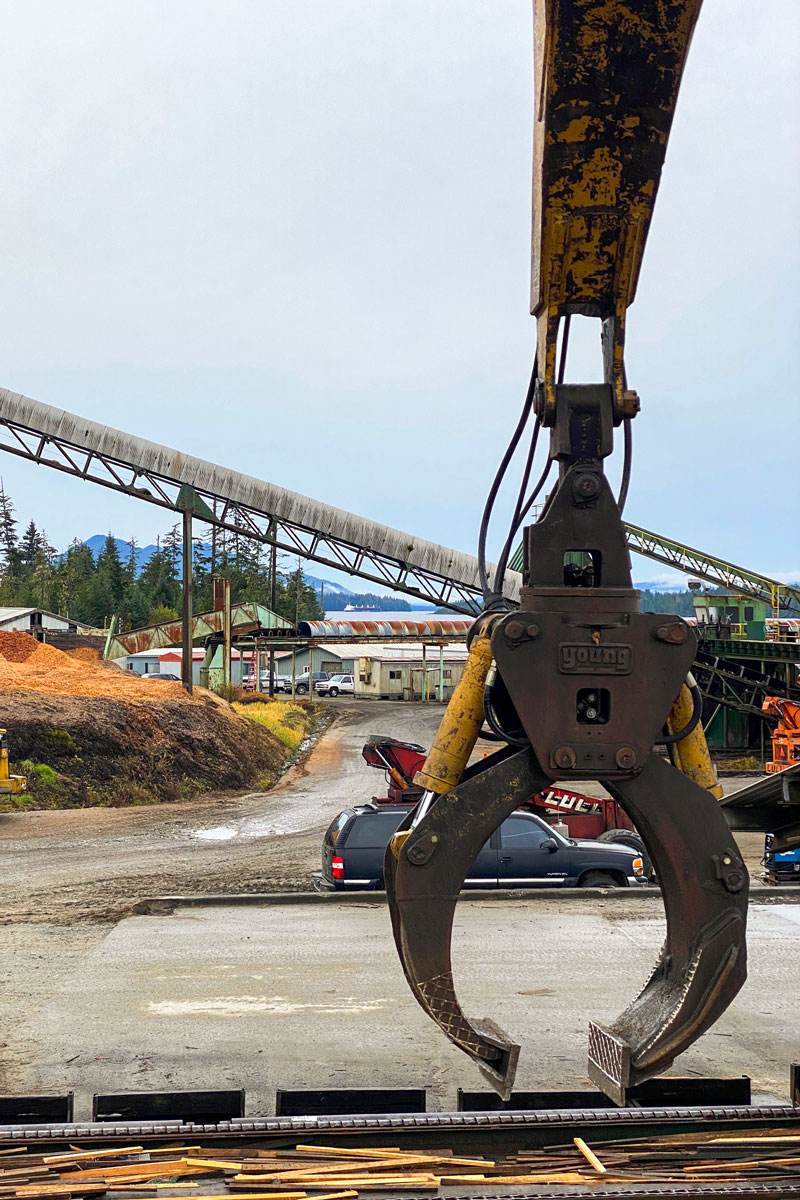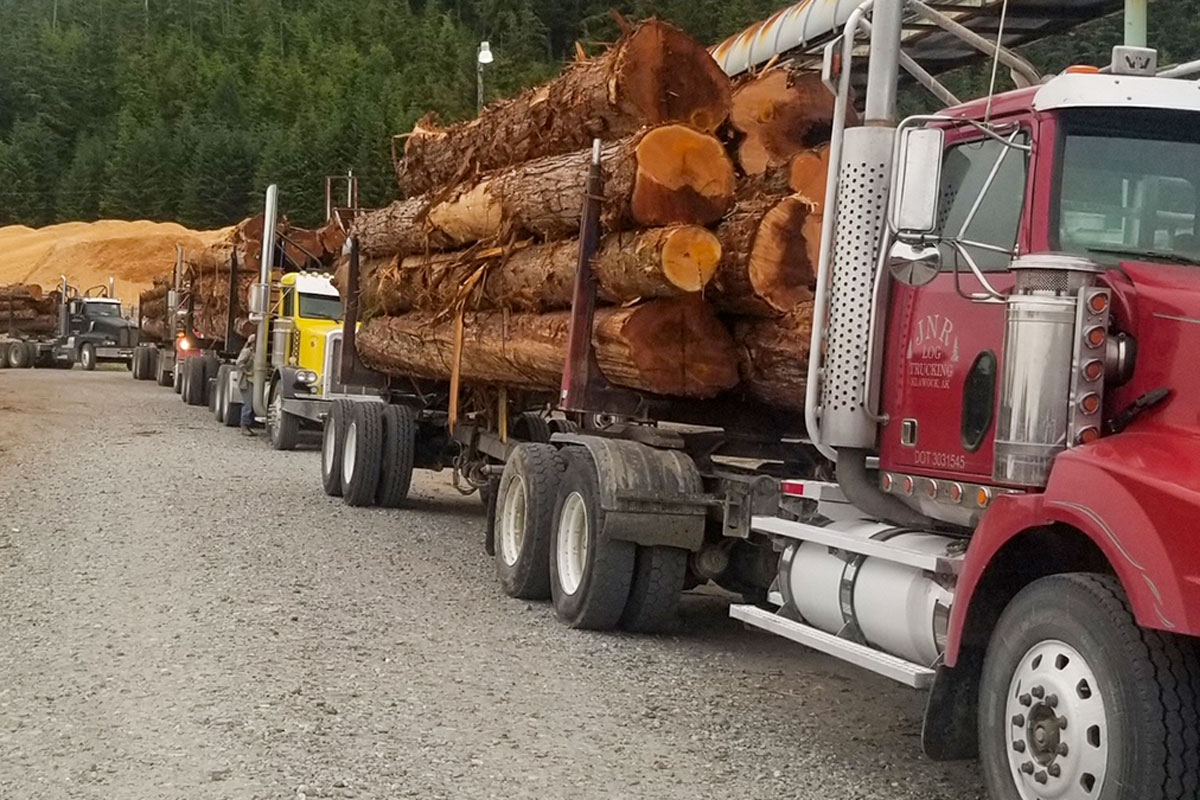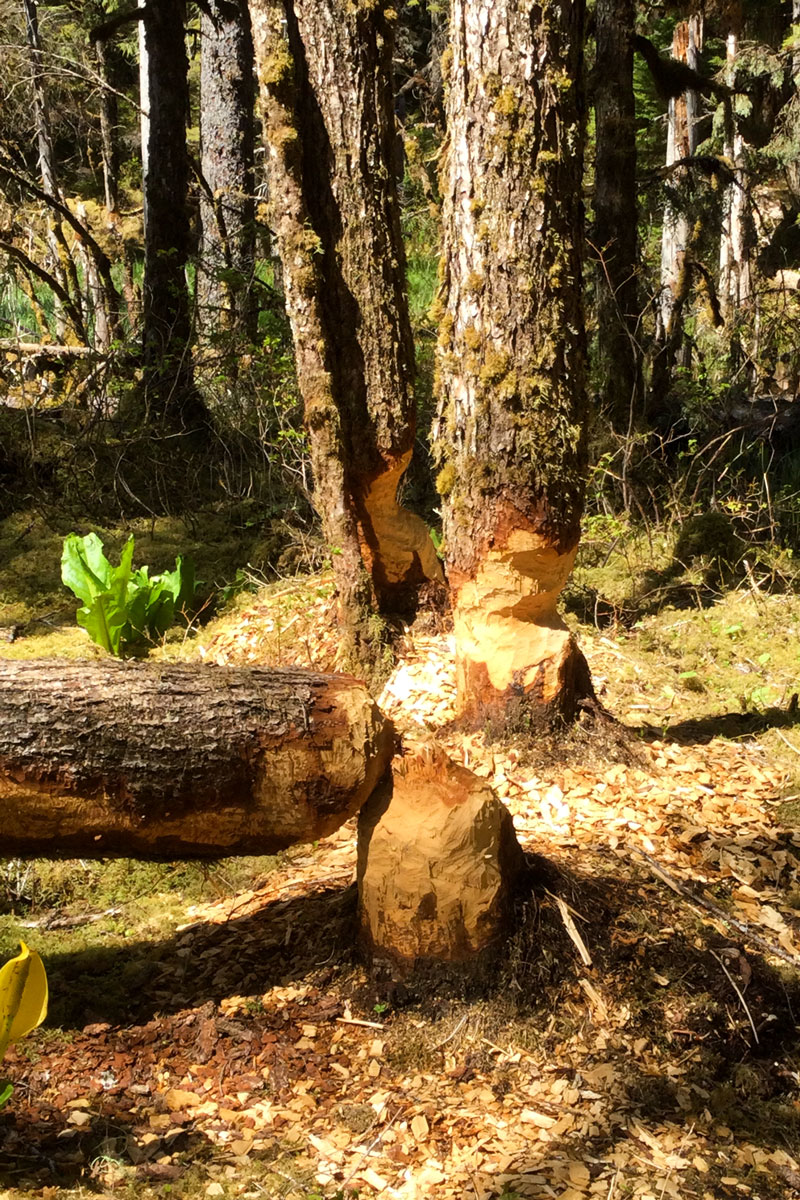AFA will provide secure, reliable, cost effective group health insurance, pension benefits and other services of value to its members.
AFA management will strive to satisfy all legitimate member and constituent needs.
AFA will be a productive and positive place of employment.
AFA will strive to maintain an authoritative and professional public image.
AFA will strive to provide accurate information and education concerning forest uses and forestry issues to AFA members, the public and the media.
AFA will work to maximize public and private timber supply throughout the state and enhance private property rights.
The Alaska Forest Association (AFA) began on Friday, March 6, 1956, when a group of loggers met in Ketchikan to establish an association for Alaska loggers. At the conclusion of the meeting, they voted to affiliate with the Timber Operators Association and selected the name S.E. Division of Timber Operators Association. During the first year of operation, the group developed a worker’s compensation program and hired a safety engineer.
In 1957, the group withdrew from the Timber Operators Association and formed its own association, the Alaska Loggers Association. In 1960, the organization voted to admit as Regular Members, sawmills and pulp mills that had logging operations. Also at this time, the Associate Member category was created.
The Association is one of the oldest in the State of Alaska and provides members the opportunity to participate in programs such as Tongass Timber Trust (group health), Alaska Loggers Retirement (pension plan) and a public information program which promotes the facts concerning the forest products industry.
In the past decade, many changes have taken place in the industry resulting in the need to broaden our image and scope. AFA no longer services only “loggers” but all facets of the industry. The Board of Directors has been enlarged to 24 directors and the organization renamed the “Alaska Forest Association” effective January 1, 1991.




The Alaska Forest Association (AFA) began on Friday, March 6, 1956, when a group of loggers met in Ketchikan to establish an association for Alaska loggers. At the conclusion of the meeting, they voted to affiliate with the Timber Operators Association and selected the name S.E. Division of Timber Operators Association. During the first year of operation, the group developed a worker’s compensation program and hired a safety engineer.
In 1957, the group withdrew from the Timber Operators Association and formed its own association, the Alaska Loggers Association. In 1960, the organization voted to admit as Regular Members, sawmills and pulp mills that had logging operations. Also at this time, the Associate Member category was created.
The Association is one of the oldest in the State of Alaska and provides members the opportunity to participate in programs such as Tongass Timber Trust (group health), Alaska Loggers Retirement (pension plan) and a public information program which promotes the facts concerning the forest products industry.
In the past decade, many changes have taken place in the industry resulting in the need to broaden our image and scope. AFA no longer services only “loggers” but all facets of the industry. The Board of Directors has been enlarged to 24 directors and the organization renamed the “Alaska Forest Association” effective January 1, 1991.
Not long following the start of the Alaska Loggers Association in 1957, the founders realized that suppliers of equipment, goods and services to logging operations were interested in participating in the Association’s development. In May, 1960, a motion to create the membership category of “Associate Members” was approved and suppliers officially became dues paying members.
After several years of hosting a “beer bust” at the annual meeting, in 1976 the event was given the title of “Red Suspenders” party. The event, marked by the emphasis on wearing of red suspenders, hickory shirts, high cut pants, and Alaska slippers, was a gathering of friends not seen since the last winter.
Throughout the years following, and growing to a membership of over 120, the Associate Members have been active in helping to promote and defend the industry in its trials and challenges. With letter writing, contacting legislative delegations, and lobbying trips to Washington, D.C., the Associate Members continue to be an important part of the Association.


Not long following the start of the Alaska Loggers Association in 1957, the founders realized that suppliers of equipment, goods and services to logging operations were interested in participating in the Association’s development. In May, 1960, a motion to create the membership category of “Associate Members” was approved and suppliers officially became dues paying members.
After several years of hosting a “beer bust” at the annual meeting, in 1976 the event was given the title of “Red Suspenders” party. The event, marked by the emphasis on wearing of red suspenders, hickory shirts, high cut pants, and Alaska slippers, was a gathering of friends not seen since the last winter.
Throughout the years following, and growing to a membership of over 120, the Associate Members have been active in helping to promote and defend the industry in its trials and challenges. With letter writing, contacting legislative delegations, and lobbying trips to Washington, D.C., the Associate Members continue to be an important part of the Association.
From the 1867 purchase of Alaska until after the 1907 proclamation establishing the Tongass National Forest, only small amounts of the timber resources in Southeast Alaska were harvested for local use. Subsequent to 1907, the newly established Forest Service began offering 25-year timber sale contracts that included a requirement to construct a pulp mill. The intent was to establish a fully integrated manufacturing industry that would utilize all of the commercial timberlands in the region. None of those early efforts were successful until the agency increased the term of the contracts to 50- years and added an assurance of an economic timber supply. Only two pulp mills were ultimately constructed, but they operated as intended from the mid-1950s until the mid-1990s. An Illegal termination of one long-term contract and the imposition of unilateral contract changes that eliminated the viability of the other long-term contract brought an abrupt end to the pulp mill operations.


From the 1867 purchase of Alaska until after the 1907 proclamation establishing the Tongass National Forest, only small amounts of the timber resources in Southeast Alaska were harvested for local use. Subsequent to 1907, the newly established Forest Service began offering 25-year timber sale contracts that included a requirement to construct a pulp mill. The intent was to establish a fully integrated manufacturing industry that would utilize all of the commercial timberlands in the region. None of those early efforts were successful until the agency increased the term of the contracts to 50- years and added an assurance of an economic timber supply. Only two pulp mills were ultimately constructed, but they operated as intended from the mid-1950s until the mid-1990s. An Illegal termination of one long-term contract and the imposition of unilateral contract changes that eliminated the viability of the other long-term contract brought an abrupt end to the pulp mill operations.
The Alaska Forest Association (AFA) began on Friday, March 6, 1956, when a group of loggers met in Ketchikan to establish an association for Alaska loggers. At the conclusion of the meeting, they voted to affiliate with the Timber Operators Association and selected the name S.E. Division of Timber Operators Association. During the first year of operation, the group developed a worker’s compensation program and hired a safety engineer.
In 1957, the group withdrew from the Timber Operators Association and formed its own association, the Alaska Loggers Association. In 1960, the organization voted to admit as Regular Members, sawmills and pulp mills that had logging operations. Also at this time, the Associate Member category was created.
The Association is one of the oldest in the State of Alaska and provides members the opportunity to participate in programs such as Tongass Timber Trust (group health), Alaska Loggers Retirement (pension plan) and a public information program which promotes the facts concerning the forest products industry.
In the past decade, many changes have taken place in the industry resulting in the need to broaden our image and scope. AFA no longer services only “loggers” but all facets of the industry. The Board of Directors has been enlarged to 24 directors and the organization renamed the “Alaska Forest Association” effective January 1, 1991.




The Alaska Forest Association (AFA) began on Friday, March 6, 1956, when a group of loggers met in Ketchikan to establish an association for Alaska loggers. At the conclusion of the meeting, they voted to affiliate with the Timber Operators Association and selected the name S.E. Division of Timber Operators Association. During the first year of operation, the group developed a worker’s compensation program and hired a safety engineer.
In 1957, the group withdrew from the Timber Operators Association and formed its own association, the Alaska Loggers Association. In 1960, the organization voted to admit as Regular Members, sawmills and pulp mills that had logging operations. Also at this time, the Associate Member category was created.
The Association is one of the oldest in the State of Alaska and provides members the opportunity to participate in programs such as Tongass Timber Trust (group health), Alaska Loggers Retirement (pension plan) and a public information program which promotes the facts concerning the forest products industry.
In the past decade, many changes have taken place in the industry resulting in the need to broaden our image and scope. AFA no longer services only “loggers” but all facets of the industry. The Board of Directors has been enlarged to 24 directors and the organization renamed the “Alaska Forest Association” effective January 1, 1991.
Not long following the start of the Alaska Loggers Association in 1957, the founders realized that suppliers of equipment, goods and services to logging operations were interested in participating in the Association’s development. In May, 1960, a motion to create the membership category of “Associate Members” was approved and suppliers officially became dues paying members.
After several years of hosting a “beer bust” at the annual meeting, in 1976 the event was given the title of “Red Suspenders” party. The event, marked by the emphasis on wearing of red suspenders, hickory shirts, high cut pants, and Alaska slippers, was a gathering of friends not seen since the last winter.
Throughout the years following, and growing to a membership of over 120, the Associate Members have been active in helping to promote and defend the industry in its trials and challenges. With letter writing, contacting legislative delegations, and lobbying trips to Washington, D.C., the Associate Members continue to be an important part of the Association.


Not long following the start of the Alaska Loggers Association in 1957, the founders realized that suppliers of equipment, goods and services to logging operations were interested in participating in the Association’s development. In May, 1960, a motion to create the membership category of “Associate Members” was approved and suppliers officially became dues paying members.
After several years of hosting a “beer bust” at the annual meeting, in 1976 the event was given the title of “Red Suspenders” party. The event, marked by the emphasis on wearing of red suspenders, hickory shirts, high cut pants, and Alaska slippers, was a gathering of friends not seen since the last winter.
Throughout the years following, and growing to a membership of over 120, the Associate Members have been active in helping to promote and defend the industry in its trials and challenges. With letter writing, contacting legislative delegations, and lobbying trips to Washington, D.C., the Associate Members continue to be an important part of the Association.
From the 1867 purchase of Alaska until after the 1907 proclamation establishing the Tongass National Forest, only small amounts of the timber resources in Southeast Alaska were harvested for local use. Subsequent to 1907, the newly established Forest Service began offering 25-year timber sale contracts that included a requirement to construct a pulp mill. The intent was to establish a fully integrated manufacturing industry that would utilize all of the commercial timberlands in the region. None of those early efforts were successful until the agency increased the term of the contracts to 50- years and added an assurance of an economic timber supply. Only two pulp mills were ultimately constructed, but they operated as intended from the mid-1950s until the mid-1990s. An Illegal termination of one long-term contract and the imposition of unilateral contract changes that eliminated the viability of the other long-term contract brought an abrupt end to the pulp mill operations.


From the 1867 purchase of Alaska until after the 1907 proclamation establishing the Tongass National Forest, only small amounts of the timber resources in Southeast Alaska were harvested for local use. Subsequent to 1907, the newly established Forest Service began offering 25-year timber sale contracts that included a requirement to construct a pulp mill. The intent was to establish a fully integrated manufacturing industry that would utilize all of the commercial timberlands in the region. None of those early efforts were successful until the agency increased the term of the contracts to 50- years and added an assurance of an economic timber supply. Only two pulp mills were ultimately constructed, but they operated as intended from the mid-1950s until the mid-1990s. An Illegal termination of one long-term contract and the imposition of unilateral contract changes that eliminated the viability of the other long-term contract brought an abrupt end to the pulp mill operations.
Bryce Dahlstrom, Viking Lumber
Eric Nichols, Alcan Forest Products
Brian Brown, Alcan Forest Products
Tessa Axelson
Bert Burkhart, Local Manufacturing, Inc
Bob Byers, Tongass Cutting
Bodine Rogers, Timber Wolf Cutting
Brian Brown, Alcan Forest Products
Christine Klein, ADK AK
Clarence Clark, SE AK Resources
Chris Morrow, Log N Road
Eric Cole, NC Machinery, Associate Member Representative
George Baggen, Samson Tug & Barge
Joe Young, Young’s Timber
Kirk Dahlstrom, Viking Lumber
Linda Lewis, West Wind Plaza
Steve Grandorff, Viking Lumber
Tyler Morrow, North Fork Timber
Join the Alaska Forest Association today and be a proactive force in shaping the future of Alaska’s timber industry.
Serving Alaska’s forest products industry and maintaining Alaska’s forest for today and tomorrow.